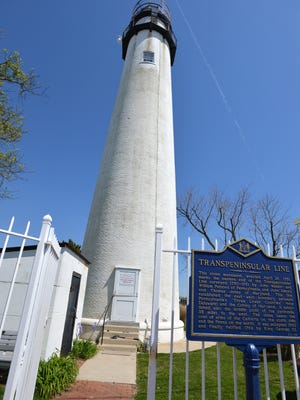A well-placed lighthouse in Fenwick
“Although we were approximately three miles inland,” the late Mary Pat Kyle, longtime coastal resident and the unofficial historian of Fenwick Island, recalled, “we could see huge breakers coming in to the shore and completely washing over the beach into the bay near the area of Fenwick Towers (built since the storm). The huge breaking waves are a sight I will never forget.”

In the middle of the 19th century, a lighthouse was authorized for Fenwick Island, and the army engineer who selected the site for the new tower must have had an experienced eye.
He placed the tower on moderately high ground about a half mile from the surf, a short distance from a salt pond that bordered the beach, and about midway between two ancient inlets that had silted closed.
One of the old inlets was located a little north of Lewes Street; and a second inlet was located less than a mile south of Delaware’s border with Maryland. In the years after the lighthouse opened in 1859, the tower would prove to be well-placed.
The old inlets had disappeared by the early 20th century, when the first vacationers appeared on Fenwick Island to build beach homes a short distance from the lighthouse. Fenwick Island’s early wooden cottages lacked electricity, running water, and other niceties; but these primitive accommodations were only a short walk from the surf.
When the coast was lashed by a strong storm in 1933, the owners of the cottages on Fenwick Island suffered some damage, and a decade later, a late summer storm drove waves across the beach and inundated some of the cottages. The high ground on which the lighthouse stood enabled the tower to escape damage.
By 1962, the number of beach houses in Fenwick Island had grown considerably, when a March high-pressure system over Canada prevented two merging low pressure systems that had formed on the Atlantic coast from moving northward; and the result was a stalled nor’easter that sat off the Delaware coast for two days.
READ MORE: Learn about fashion in Seaford
The storm sent steady gale force winds and pounding waves across the beach, and in some places, into the rain-swollen coastal bays. At Fenwick Island, old inlets that had remained dormant for a century were reopened; and the ocean flowed freely into Assawoman Bay.
As the storm began to abate, Mary Pat Kyle made her way along Route 54 in an effort to reach her oceanfront property.
Stopped by the high water near Fenwick West, Kyle crossed the road to a small cemetery that sat on a small elevation on the north side of Route 54. The beach was still some distance away, but Kyle could clearly see that most of Fenwick Island was submerged.
According to the Delaware Coast Press, “The ocean highway at mid-point of Dewey Beach all the way to Fenwick Island was under deep water and by the bay side two automobiles rested in water that almost hid them from view. Homes in this area were flooded and not only water but sand, reached almost to six feet in height.”
READ MORE: New photo shows 'beautiful, resilient' Harriet Tubman
By the time that the nor’easter had left, the beach was littered with chunks of broken buildings, piles of debris, and tons of storm-swept sand. The 1962 storm reduced nearly 2,000 Delaware beach houses to splintered timbers and caused an estimated $400 million in damages.
Since that time, several strong nor’easters have struck the Delaware coast, but the damage done by recent storms, however, pales when compared to the devastation caused by the March 1962 nor’easter that submerged Fenwick Island, where the area around the Fenwick Island Lighthouse escaped the rising water and proved that the tower was well-placed.